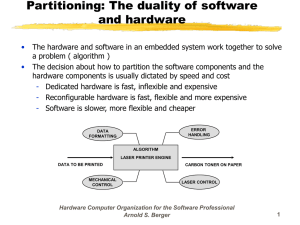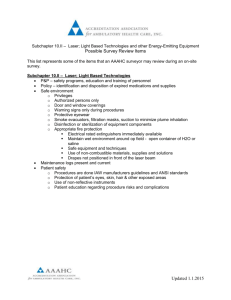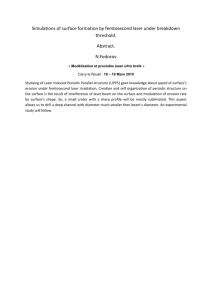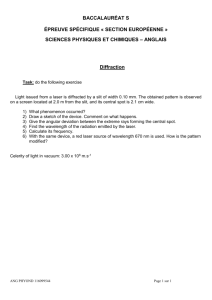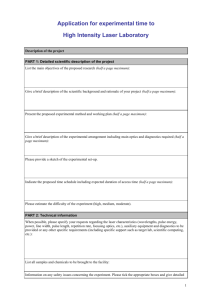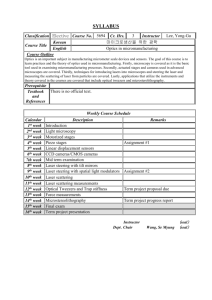GEOPHYSICAL RESEARCH XII.
advertisement
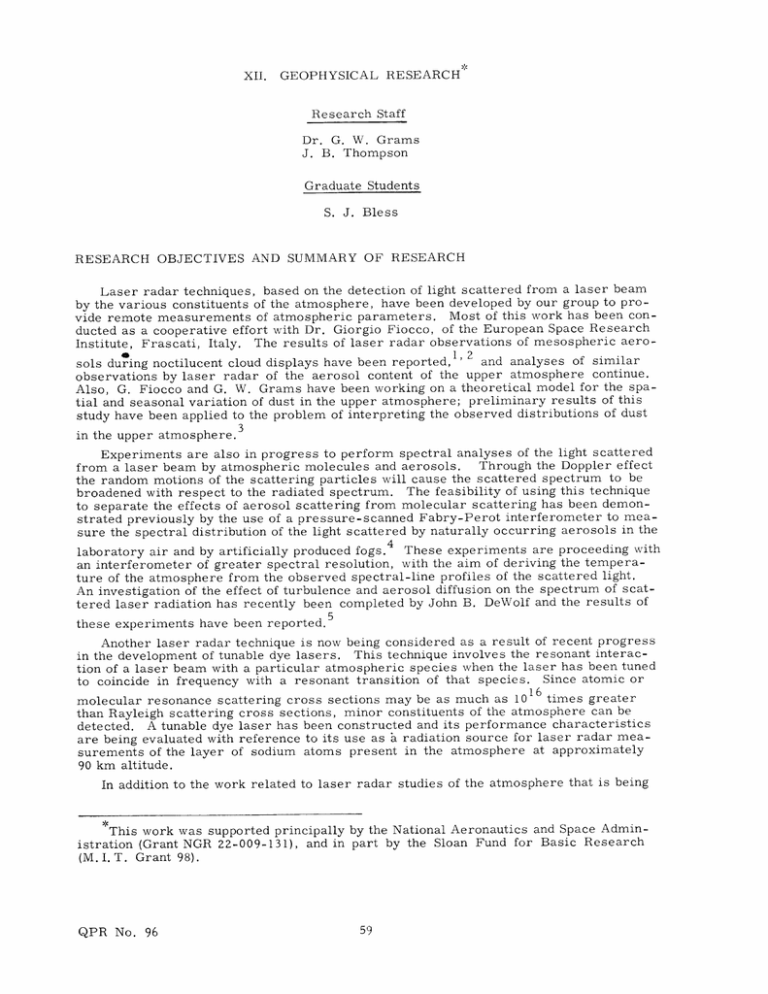
XII. GEOPHYSICAL RESEARCH Research Staff Dr. G. W. Grams J. B. Thompson Graduate Students S. J. Bless RESEARCH OBJECTIVES AND SUMMARY OF RESEARCH Laser radar techniques, based on the detection of light scattered from a laser beam by the various constituents of the atmosphere, have been developed by our group to provide remote measurements of atmospheric parameters. Most of this work has been conducted as a cooperative effort with Dr. Giorgio Fiocco, of the European Space Research Institute, Frascati, Italy. The results of laser radar observations of mesospheric aero1, 22 * and analyses of similar sols during noctilucent cloud displays have been reported, observations by laser radar of the aerosol content of the upper atmosphere continue. Also, G. Fiocco and G. W. Grams have been working on a theoretical model for the spatial and seasonal variation of dust in the upper atmosphere; preliminary results of this study have been applied to the problem of interpreting the observed distributions of dust in the upper atmosphere. 3 Experiments are also in progress to perform spectral analyses of the light scattered Through the Doppler effect from a laser beam by atmospheric molecules and aerosols. the random motions of the scattering particles will cause the scattered spectrum to be broadened with respect to the radiated spectrum. The feasibility of using this technique to separate the effects of aerosol scattering from molecular scattering has been demonstrated previously by the use of a pressure-scanned Fabry-Perot interferometer to measure the spectral distribution of the light scattered by naturally occurring aerosols in the 4 These experiments are proceeding with laboratory air and by artificially produced fogs. an interferometer of greater spectral resolution, with the aim of deriving the temperature of the atmosphere from the observed spectral-line profiles of the scattered light. An investigation of the effect of turbulence and aerosol diffusion on the spectrum of scattered laser radiation has recently been completed by John B. DeWolf and the results of these experiments have been reported. 5 Another laser radar technique is now being considered as a result of recent progress in the development of tunable dye lasers. This technique involves the resonant interaction of a laser beam with a particular atmospheric species when the laser has been tuned to coincide in frequency with a resonant transition of that species. Since atomic or 16 times greater molecular resonance scattering cross sections may be as much as 10 than Rayleigh scattering cross sections, minor constituents of the atmosphere can be detected. A tunable dye laser has been constructed and its performance characteristics are being evaluated with reference to its use as a radiation source for laser radar measurements of the layer of sodium atoms present in the atmosphere at approximately 90 km altitude. In addition to the work related to laser radar studies of the atmosphere that is being This work was supported principally by the National Aeronautics and Space Administration (Grant NGR 22-009-131), and in part by the Sloan Fund for Basic Research (M. I. T. Grant 98). QPR No. 96 (XII. GEOPHYSICAL RESEARCH) conducted by our group, a concurrent investigation of the effects of high pressures in solids is being carried out by Stephen J. Bless. A capacitor discharge driven linear magnetic pinch is being used to study phase stabilities of materials of geophysical inter6 est, and preliminary results obtained with the apparatus have been reported. This device utilizes the effects of intense pulsed magnetic fields to produce high pressures in the material. Irreversible changes in the index of refraction of silica glass have been demonstrated by pressures as high as 300 kilobars. The apparatus has now been instrumented to allow measurement of pressure-induced changes in resistivity as a means of obtaining pressure calibrations. G. W. Grams References 1. 2. G. Fiocco and G. W. Grams, "Optical Radar Observations of Mesospheric Aerosols in Norway during the Summer 1966," J. Geophys. Res. 74, 2453-2458 (1969). G. W. Grams, "Noctilucent Cloud Studies," Report presented at the Second Conference on Lidar Uses in Atmospheric Research, Brookhaven National Laboratary, Upton, New York, April 1969. 3. G. Fiocco and G. W. Grams, "Motion of Aerosols in the Upper Atmosphere," a paper presented at the Open Meeting of the Cosmic Dust Panel, COSPAR Meeting, Prague, Czechoslovakia, May 1969. 4. G. Fiocco and J. B. DeWolf, "Frequency Spectrum of Laser Echoes from Atmospheric Constituents and Determination of the Aerosol Content of Air," J. Atmos. Sci. 25, 488-496 (1968). 5. J. B. DeWolf, "Homodyne Studies of Light Scattered from a Turbulent Water Jet," Ph.D. Thesis, M.I.T., Cambridge, Mass., June 1969. 6. S. J. Bless, "Production of High Pressures with a Magnetic Pinch," a paper presented at 56th Annual Meeting of the American Geophysical Union, Washington, D. C., April 1969; Abstract in Trans. Am. Geophys. Union, Vol. 50, No. 4, 1969. QPR No. 96
